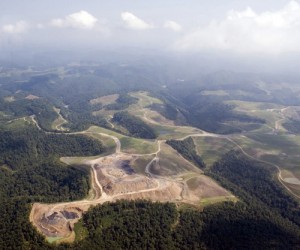EARTHTALK: Banks funding destructive mountaintop removal mining
EARTHTALK: Banks funding destructive mountaintop removal mining

Many major banks invest in companies that engage in the environmentally destructive practice of mountaintop removal coal mining, whereby the tops of mountains are blown up to expose the recoverable coal. Despite some banks' stated intent to limit such financing, a Sierra Club/Rainforest Action Network "report card" indicates that few are yet walking the talk. PHOTO: Ilovemountains.org
Yes it’s true that many major banks invest in companies that engage in the environmentally destructive practice of mountaintop removal (MTR) coal mining, whereby the tops of mountains are removed by explosives to expose thin seams of recoverable coal. The wasted earth and other materials are either put back onto the mountain top in an approximation of their original contours, wreaking havoc on local ecosystems and biodiversity, or dumped into neighboring valleys, polluting lakes and streams and jeopardizing water quality for humans and wildlife.
According to the non-profit Rainforest Action Network (RAN), this dumping—especially throughout Appalachia where MTR is most prevalent—“undermines the objectives and requirements of the Clean Water Act.” The group adds that some 2,000 miles of streams have already been buried or contaminated in the region. “The mining destroys Appalachian communities, the health of coalfield residents and any hope for positive economic growth.”
This past April, RAN teamed up for the second year in a row with another leading non-profit green group concerned about MTR, the Sierra Club, in publishing a “report card” reviewing 10 of the world’s largest banks in regard to their financing of MTR coal mining projects. The new 2011 version of “Policy and Practice” takes a look at the MTR-related financing practices of Bank of America, CitiBank, Credit Suisse, Deutsche Bank, GE Capital, JPMorgan Chase, Morgan Stanley, PNC, UBS and Wells Fargo.
What did they find? Since January 2010, the 10 banks reviewed have provided upwards of $2.5 billion in loans and bonds to companies practicing MTR. While some of the banks—Chase, Wells Fargo, PNC, UBS, and Credit Suisse—adopted policies limiting their financing of MTR, few actually pulled funding in place from any such activities upon adopting such policies. Citibank, despite announcing publicly in 2009 that it would limit its involvement in MTR, doubled its investments in the business in 2010.
RAN and the Sierra Club are also keeping a close eye on UBS which, soon after stating that it “needs to be satisfied that the client is committed to reduce over time its exposure to [MTR],” went ahead and acted as a paid advisor on the merger of Massey Energy, which operated the West Virginia mine where 29 men died last year, and Alpha Natural Resources. This merger created the largest single MTR company in the country, now responsible for some 25 percent of coal production from MTR mines.
The report card grades each bank based on its current position and practice regarding MTR investments, and calls on the banks to strengthen their policies and cease their financial support for coal companies engaging in MTR. “The ‘best practice’…is a clear exclusion policy on commercial lending and investment banking services for all coal companies who practice mountaintop removal coal extraction,” says RAN.
RAN and the Sierra Club hope that by exposing the impact these banks are having on the environment through their financing programs, they can help alert the public and policymakers to the need to outlaw MTR coal mining altogether.
CONTACTS: Rainforest Action Network, www.ran.org; Sierra Club, www.sierraclub.org.
EarthTalk® is written and edited by Roddy Scheer and Doug Moss and is a registered trademark of E – The Environmental Magazine (www.emagazine.com). Send questions to: earthtalk@emagazine.com. Subscribe: www.emagazine.com/subscribe. Free Trial Issue: www.emagazine.com/trial.



Comments (0)